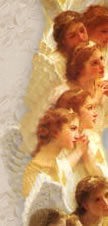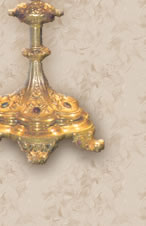|
We have chosen for our website theme throughout
various vignettes from the illustrious Papal Basilica
of St. Mary Major in Rome in honor of the
Blessed Virgin Mary, our beloved Mother of the
Church and our Patroness.
 "The
Basilica di
Santa Maria Maggiore — also known as the Basilica di Santa Maria della Neve and
Basilica Liberiana in the Italian language and
Saint Mary Major Basilica or the Liberian
Basilica in the English language — is an ancient
Catholic basilica of Rome. It is one of the four
major basilicas, and one of the five Patriarchal
basilicas associated with the Pentarchy: "The
Basilica di
Santa Maria Maggiore — also known as the Basilica di Santa Maria della Neve and
Basilica Liberiana in the Italian language and
Saint Mary Major Basilica or the Liberian
Basilica in the English language — is an ancient
Catholic basilica of Rome. It is one of the four
major basilicas, and one of the five Patriarchal
basilicas associated with the Pentarchy:
St. John
Lateran, St. Lawrence outside the Walls, St. Peter
and St. Paul outside the Walls, and Santa Maria Maggiore.
Situated on the summit of the Esquiline Hill, St.
Mary Major is the only one of the four patriarchal
basilicas to have retained its paleo-Christian
structures.
Tradition has it that the Virgin Mary herself
inspired the choice of the Esquiline Hill for the
church's construction. Appearing in a dream to both
the Patrician John and Pope Liberius, she asked that
a church be built in her honor in a place that she
would miraculously indicate.
The morning of August 5th, the Esquiline Hill was
covered with a blanket of snow. The pope traced the
perimeter and John financed the construction of the
new church.
Nothing remains of this church but a few lines in
the Liber Pontificalis affirming that Pope Liberius
"Fecit basilicam nomini suo iuxta Macellum Liviae."
Recent excavations underneath the present church
have not brought to light any remains of this
ancient structure; however many important
archeological monuments such as the stupendous
calendar from the second or third century AD and
remains of Roman walls have been discovered.
The Romanesque bell tower, built by Gregory XI
after his return from Avignon, rises 75 meters high
and is the tallest in Rome. The belfry contains five
bells, one of which, "La Sperduta," or "the lost
one," rings every evening at nine with its
distinctive sound to call the faithful to prayer.
To the right upon entering the portico stands a
statue of King Phillip IV of Spain, a benefactor of
the Basilica. The clay model for this sculpture was
created by Gian Lorenzo Bernini in the seventeenth
century, though Girolamo Lucenti carved the finished
work. The central door is made of bronze and was
cast by Ludovico Pogliaghi in 1949, showing episodes
from the life of Mary framed by images of Prophets,
Evangelists and the four women of the Old Testament
who prefigure the Blessed Virgin. To the left stands
the new Holy Door, blessed by John Paul II on
December 8, 2001, completed by sculptor Luigi Mattei
and donated to the basilica by the Order of the
Knights of the Holy Sepulchre in Jerusalem.
The right panel of the Holy Door shows the
Resurrected Christ modelled after the image on the
Shroud of Turin, who appears to Mary, represented
here as Salus Populi Romani. In the upper left
corner lies a representation of the Annunciation at
the Well, a story drawn from apocryphal Gospels,
while on the right there is an image of Pentecost.
The lower corners display on the left, the Council
of Ephesus which proclaimed Mary as THEOTOKOS,
Mother of God and on the right, the Second Vatican
Council which declared Mary Mater Ecclesiae or
Mother of the Church. The Papal coat-of-arms of John
Paul II, as well as his motto Totus Tuus, lies above
the door, while the two emblems further down are
those of Cardinal Carlo Furno, archpriest of the
Basilica in 2001, and of the Order of the Holy
Sepulchre.
The present Basilica dates back to the fifth
century AD. Its construction was tied to the Council
of Ephesus of 431 AD, which proclaimed Maria
Theotokos, Mother of God. Sixtus III, as Bishop of
Rome, commissioned and financed the project.
Crossing the threshold, one is overwhelmed by the
vision of vast space, splendid marbles, and
marvelous decoration.
The monumental effect is due to the structure of
the basilica and the harmony that reigns among the
principal architectural elements. Constructed
according to Vitruvius' canon of rhythmic elegance,
the basilica is divided into a nave and two side
aisles by two rows of precious columns. Above these
columns runs the skillfully wrought entablature,
interrupted at the transept by the grand arches
erected for the building of the Sistine and Pauline
chapels. The area between the columns and the
ceiling was once punctuated by large windows, half
of which still remain, while the other half have
been walled up.
Over the walled windows, today one can admire
frescos showing Stories from the Life of the Virgin.
Above the window and frescos, a wooden frieze
adorned with an exquisite inlay of putti figures
riding bulls unites the cornice with the ceiling.
The bulls are the symbol of the Borgia family, and
the emblems of Callixtus III and Alexander VI, the
Borgia popes, stand out at the center of the
ceiling. It is not clear what contribution Callixtus
III made to this work, but it is certain that
Alexander VI carried out the project while he was
still archpriest of the Basilica.
The coffered ceiling was designed by Giuliano
Sangallo and later completed by his brother Antonio.
Tradition has it that the gilding was an offering
from Isabella and Ferdinand of Spain to Alexander
VI, and that it used the first gold brought from the
New World. The pavement of intricately inlaid stones
extends before us like a splendid carpet. Designed
by the marble masters of the Cosmati family in the
thirteenth century, it was donated by the Roman
nobleman Scotus Paparoni and his son Giovanni.
The unique quality of St. Mary Major however,
comes from the fifth century mosaics, commissioned
by Sixtus III, that run along the nave and across
the triumphal arch. The nave mosaics recount four
cycles of Sacred History featuring Abraham, Jacob,
Moses and Joshua; seen together, they are meant to
testify to God s promise of a land for the Jewish
people and His assistance as they strive to reach
it.
The story, which does not proceed in
chronological order, starts on the left-hand wall
near the triumphal arch with the Sacrifice of the
Priest-King Melchisedek. This panel shows clear
Roman iconographic influence. Melchisedek is seen
using the customary gesture of offering, while
Abraham, wearing a Roman toga, is reminiscent of the
equestrian statue of Marcus Aurelius. The next
scenes illustrate earlier episodes from the life of
Abraham. For a long time, scholars thought that each
mosaic was independent of the others, but upon
further study it appears that the decoration was
planned and organized to hold special meaning.
The Melchisedek panel ties the nave images
together with those of the triumphal arch which
recount the infancy of Christ, King and Priest. Then
begins the narrative of Abraham, the most important
personage of the Old Testament, to whom God promised
a great and powerful nation. The stories continue
with Jacob, with whom God renews the promise made to
Abraham, Moses, who liberates his people from the
slavery in which they were born, making them the
chosen people, and finally Joshua, who will lead
them to the Promised Land. The journey concludes
with two final panels, done in fresco at time of the
restoration of Cardinal Pinelli, which show David
leading the Ark of the Covenant into Jerusalem, and
the Temple of Jerusalem built by Solomon. Jesus was
born from the line David, and thus Christ s
childhood, as narrated in apocryphal Gospels, is
illustrated in the triumphal arch.
In 1995, a new, rose window in stained glass was
created for the main façade by Giovanni Hajnal. It
reaffirms the declaration of the Second Vatican
Council that Mary, the exalted daughter of Zion, is
the link that unites the Church to the Old
Testament. To symbolize the Old Testament, Hajnal
used the seven-branched candlestick, for the New
Testament, the chalice of the Eucharist.
The triumphal arch is composed of four registers.
The first, in the upper left, shows the
Annunciation, with Mary robed like a Roman princess.
She holds a spindle as she weaves a purple veil for
the Temple where she serves. The story continues
with the Annunciation to Joseph, the Adoration of
the Magi and the Massacre of the Innocents. In this
last scene, there is a woman in a blue robe facing
away from the other women; she is St. Elizabeth,
fleeing with her son John the Baptist in her arms.
The upper right illustrates the Presentation at
the Temple, the Flight to Egypt and the encounter
between the Holy Family and Aphrodisius, governor of
Sotine. Apocryphal Gospels recount that when Jesus
took refuge in Sotine in Egypt, the 365 idols of the
capitol fell down. Awed by this prodigy, Aphrodisius,
remembered the fate of the Pharaoh and hastened with
his army to adore the Child Jesus, recognizing His
Divinity.. The last scene represents the Magi before
Herod.
At the bottom of the arch lie two cities,
Bethelem on the left and Jerusalem on the right.
Bethelem is the place where Jesus was born and where
the Epiphany took place while Jerusalem is the where
He died and rose again. The obvious connection
between these scenes and the theme of the
Apocalypse, the Second Coming at the end of time,
can be seen in the empty throne in the center of the
arch, flanked by St. Peter, who was called by Christ
to spread the Good News among the Jews, and St.
Paul, entrusted to evangelize the Gentiles. Together
they will form the church of which Peter is the
leader, and Sixtus III is his successor. In his role
of Episcopus plebi Dei the Pope s duty is to guide
the people of God towards the celestial Jeruselem.
In the thirteenth century, Nicholas IV, the first
Franciscan pope, decided to destroy the old apse and
construct the present one, placing it several meters
back so as to create a transept for the choir
between the arch and the apse. The decoration of the
apse was executed by the Franciscan Jacopo Torriti,
and the work was paid for by Cardinals Giacomo and
Pietro Colonna.
Torriti's mosaic is divided into two distinct
parts. The central medallion of the apse shows the
Coronation of the Virgin while the lower band
illustrates the most important moments of her life.
In the center of the medallion, enclosed by
concentric circles, Jesus and Mary are seated on a
large oriental throne. The Son is placing a jeweled
crown on Mary s head. In this mosaic, Mary is not
only seen as mother but as Mother Church, bride of
her Son. The sun, the moon and a chorus of adoring
angels are arranged around their feet, while St.
Peter, St. Paul, and St. Francis of Assisi along
with Pope Nicholas IV flank them on the left. On the
right, Torriti portrayed St. John the Baptist,
St.John the Evangelist, St. Anthony and the donor,
Cardinal Colonna.
The rest of the apse decoration is composed of
two acanthus trees placed at the extreme left and
right of the mosaic whose branches curl and blossom
around the gold background. In the lower apse,
mosaic scenes showing the life of the Madonna are
arranged to the left and right of the central panel
which represents the Dormition of the Virgin. Placed
directly below the Coronation medallion, the image
describing the death of Mary frequently occurs in
Byzantine iconography, but circulated widely in the
west as well after the Crusades.
Mary is represented lying on a bed, as angels
prepare to transport her body to Heaven under the
eyes of the astonished apostles. Jesus stands next
to Mary, cradling her white soul, about to carry it
to Paradise. Torriti embellished the scene with two
little Franciscan figures and a layman wearing a
thirteenth century cap. Below the Dormition Pope
Benedict XIV placed the splendid painting of the
Nativity of Christ by Francesco Mancini. Between the
ionic pilasters arranged under the mosaics,
Ferdinando Fuga placed a series of low-relief panels
by Mino del Reame representing the Nativity, the
Miracle of the Snows and the Foundation of the
Basilica under Pope Liberius, the Assumption of the
Virgin and the Adoration of the Magi. Fuga also
designedthe graceful canopy that rises over the
central altar.
The Confession, or reliquary crypt, lies before
the main altar, and was constructed by Virginio
Vespignani at the behest of Pope Pius IX to contain
the sacred relic of the Holy Crib. The crystal
reliquary, shaped like a crib, contains pieces of
ancient wood which tradition holds to be part of the
manger where Baby Jesus was laid. The Ambassadress
of Portugal donated the reliquary which was designed
by Giuseppe Valadier. The statue of Pius IX, the
Pope of the Immaculate Conception, was sculpted by
Ignazio Jacometti and placed in the crypt by Leo
XIII.
The Holy Crib
In the crypt under the high altar lies the
celebrated relic known as the Holy Crib. A statue of
Pope Pius IX kneeling before the ancient wooden
pieces of the manger serves as an example to the
faithful who come to see the first humble crib of
the Savior. Pius IX s devotion to the Holy Crib led
him to commission the crypt chapel, and his coat-of
arms is visible above the altar. The precious
crystal urn trimmed in silver, through which the
faithful can venerate the relic, was designed by
Giuseppe Valadier.
Arnolfo di Cambio's "Crib"
The spiritual and sentimental image of the
reconstruction of a "Crib" reminding a venerate
occasion, has got its origins since 432 when Pope
Sisto the Third (432/40) created a "cave of the
Nativity" similar to Bethlehem in the primitive
Basilica. The numerous pilgrimages coming back to
Rome from the Holy Land, brought as a gift precious
fragments of the Holy Cradle (cunambulum) which are
nowadays kept in the golden Confessional shrine.
During the following centuries several popes took
care of Sisto the Third's Holy Crave, until pope
Nicolò the Fourth in 1288 ordered Arnolfo di Cambio
a sculpture representing the "Nativity".
Many changes and re-buildings took place in the
basilica. When Pope Sisto the Fifth (1585/90) wanted
to build a big Chapel called the Blessed Sacrament
or Sistina in the right nave, ordered the architect
Domenico Fontana to transfer there the ancient "
cave of the Nativity" with the surviving Arnolfo di
Cambio's sculptural elements without dismantle it.
The three Magi, with dresses and shoes in elegant
and rude gothic style, and Saint Joseph, admire
astonished and reverent the miracle of the Baby in
the Virgin Mary's arms (of P. Olivieri) warmed by
the ox and the donkey.
http://www.vatican.va/various/sm_maggiore/en/storia/interno.htm
|





















